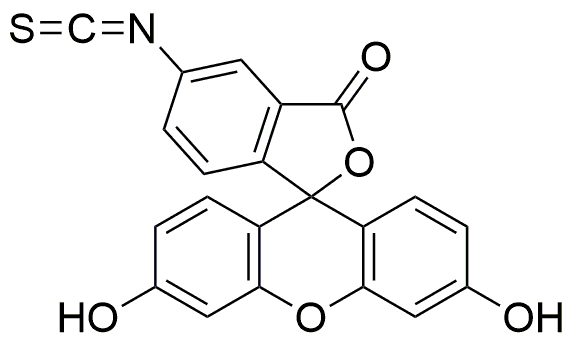Fluorescein 5(6)-isothiocyanate is widely utilized in research focused on:
- Bioconjugation: This compound is commonly used to label biomolecules such as proteins and antibodies, making it easier to track and study their interactions in biological systems.
- Fluorescent Microscopy: Its bright fluorescence allows researchers to visualize cellular structures and processes, enhancing the understanding of cellular dynamics in fields like cell biology and pathology.
- Immunoassays: This chemical is integral in developing sensitive detection methods for various analytes, improving the accuracy of diagnostic tests in clinical laboratories.
- Drug Development: In pharmaceutical research, it aids in tracking drug delivery and distribution within cells, providing insights into the efficacy and mechanisms of new therapies.
- Environmental Monitoring: The compound is also applied in detecting pollutants and toxins in environmental samples, helping researchers assess ecological impacts and ensure safety standards.
General Information
Properties
Safety and Regulations
Applications
Fluorescein 5(6)-isothiocyanate is widely utilized in research focused on:
- Bioconjugation: This compound is commonly used to label biomolecules such as proteins and antibodies, making it easier to track and study their interactions in biological systems.
- Fluorescent Microscopy: Its bright fluorescence allows researchers to visualize cellular structures and processes, enhancing the understanding of cellular dynamics in fields like cell biology and pathology.
- Immunoassays: This chemical is integral in developing sensitive detection methods for various analytes, improving the accuracy of diagnostic tests in clinical laboratories.
- Drug Development: In pharmaceutical research, it aids in tracking drug delivery and distribution within cells, providing insights into the efficacy and mechanisms of new therapies.
- Environmental Monitoring: The compound is also applied in detecting pollutants and toxins in environmental samples, helping researchers assess ecological impacts and ensure safety standards.
Documents
Safety Data Sheets (SDS)
The SDS provides comprehensive safety information on handling, storage, and disposal of the product.
Product Specification (PS)
The PS provides a comprehensive breakdown of the product’s properties, including chemical composition, physical state, purity, and storage requirements. It also details acceptable quality ranges and the product's intended applications.
Certificates of Analysis (COA)
Search for Certificates of Analysis (COA) by entering the products Lot Number. Lot and Batch Numbers can be found on a product’s label following the words ‘Lot’ or ‘Batch’.
*Catalog Number
*Lot Number
Certificates Of Origin (COO)
This COO confirms the country where the product was manufactured, and also details the materials and components used in it and whether it is derived from natural, synthetic, or other specific sources. This certificate may be required for customs, trade, and regulatory compliance.
*Catalog Number
*Lot Number
Safety Data Sheets (SDS)
The SDS provides comprehensive safety information on handling, storage, and disposal of the product.
DownloadProduct Specification (PS)
The PS provides a comprehensive breakdown of the product’s properties, including chemical composition, physical state, purity, and storage requirements. It also details acceptable quality ranges and the product's intended applications.
DownloadCertificates of Analysis (COA)
Search for Certificates of Analysis (COA) by entering the products Lot Number. Lot and Batch Numbers can be found on a product’s label following the words ‘Lot’ or ‘Batch’.
*Catalog Number
*Lot Number
Certificates Of Origin (COO)
This COO confirms the country where the product was manufactured, and also details the materials and components used in it and whether it is derived from natural, synthetic, or other specific sources. This certificate may be required for customs, trade, and regulatory compliance.


